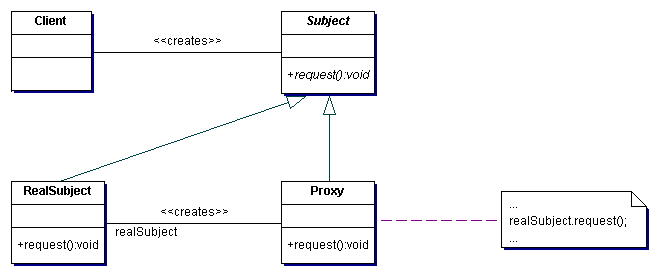Proxy
Intent
Provide a surrogate or placeholder for another object to control access
to it.
Problem
You need to support resource-hungry objects, and you do not
want to instantiate such objects unless and until they are actually
requested by the client.
Discussion
Design a surrogate, or proxy, object that: instantiates the real object
the first time the client makes a request of the proxy, remembers the
identity of this real object, and forwards the instigating request to
this real object. Then all subsequent requests are simply forwarded
directly to the encapsulated real object.
There are four common situations in which the Proxy pattern is applicable.
A virtual proxy is a placeholder for "expensive to create" objects.
The real object is only created when a client first requests/accesses
the object.
A remote proxy provides a local representative for an object that
resides in a different address space. This is what the "stub" code in
RPC and CORBA provides.
A protective proxy controls access to a sensitive master object. The
"surrogate" object checks that the caller has the access permissions
required prior to forwarding the request.
A smart proxy interposes additional actions when an object is
accessed. Typical uses include:
- Counting the number of references to the real object so that it
can be freed automatically when there are no more references (aka smart
pointer),
- Loading a persistent object into memory when it's first referenced,
- Checking that the real object is locked before it is accessed to
ensure that no other object can change it.
Structure

Example
The Proxy provides a surrogate or place holder to provide access to an
object. A check or bank draft is a proxy for funds in an account. A
check can be used in place of cash for making purchases and ultimately
controls access to cash in the issuer's account. [Michael Duell,
"Non-software examples of software design patterns", Object
Magazine, Jul 97, p54]
Non-software example
Rules of thumb
Adapter provides a different interface to its subject. Proxy provides
the same interface. Decorator provides an enhanced interface. [GOF.
p216]
Decorator and Proxy have different purposes but similar structures.
Both describe how to provide a level of indirection to another object,
and the implementations keep a reference to the object to which they
forward requests. [GOF, p220]
C++ Demos | Java Demos | Lab
